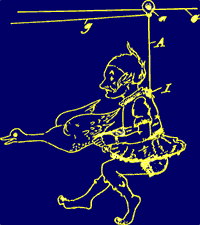Effect: The performer predicts, with a red arrow drawn on a map, the town which will be freely
chosen by a spectator from among the map’s table of contents.
Preparation: You need a map of a state (California, Kansas, etc.), or the country you’re living in, which is printed on two sides. The effect was originally devised for a complete map of Germany. Additionally, the map should have a small booklet containing the index of all towns in alphabetical order.
The table of contents should have two or three columns on each page—this is necessary for the force later on. You need to find a page where only towns starting with one letter (for example "S") are indexed. On that page find the names of two cities that are not too far away from each other on the index) but are located on opposite sides of the map.(For example on a map of California, San Francisco and San Diego should be close together in the index, but printed on opposite sides of the map due to their geographical location).
Open and bend the booklet backward very firmly at this page, "crimping" it and simplifying its force later on.
Cut out two arrows from either red paper or cardboard and glue them on each side of the map pointing toward your two "force" towns (alternatively, you can really draw the arrows on the map just make sure the ink doesn’t show through on the other side). You now have a two-way "out" for the magician’s choice that is to follow.
Performance: Hand the folded map to a spectator for safe-keeping or put it in a place where everybody can see it. This is your prediction. The index-booklet is given to another spectator and he is asked to open it to any page he likes. Because of your crimp there is a good chance he’ll open the booklet at your force-page.
In case he doesn’t, ask the spectator to flip through the pages, examine the booklet, look for his hometown, etc. Afterward, take the booklet yourself and riffle it on the side until the spectator says "stop." Time your actions and words precisely so the spectator stops you at the force-page (similar to Bill Simon’s peek force done with a deck of cards).
Look on the "randomly" selected page and say, "Here at the letter ‘S’—okay." Hold the booklet so the spectator can see this page; the audience, however, should not be able to see inside. "There are several columns with the letter ‘S’ which one do you prefer?" Subtly point with your right first finger to the two force columns (those containing the names of the two towns predicted on the map). The spectator now freely chooses one of the columns. As if to make sure which column is selected, ask, "The fifth one, right?" The assisting spectator, for whom everything looks fair, will agree, but the audience gets the impression that the spectator had a choice between five or more columns.
Move your first finger over the selected column until the spectator again says "stop." Time the movement of your finger so the spectator stops you at the force-town. The small printing will give you some leeway. It looks best if you really touch the page with your first finger instead of floating over the page while you move the finger downward. If you should miss the city you can secretly readjust by rolling your finger upward or downward (as if giving a fingerprint). With a little practice, however, you should be able to get the timing right so you hit the force town immediately.
The spectator is asked to read aloud the name of the town he has selected. At this point you can either perform a one handed duck-flourish ...

... or reiterate how fair the selection process was. Do whichever fits your style best.
All that remains is to open the map on the correct side and present your prediction to the spectator, who in turn confirms the name for the rest of the audience.
When opening the map be careful not to flash the second arrow on the other side. This might require some sleight of hand with the origami-like folds of some current maps.
